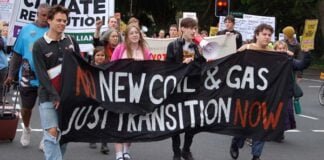Buried in the fine print of Labor’s carbon tax package is the admission that greenhouse gas emissions will keep rising for decades into the future. Treasury modelling indicates emissions will continue to rise until 2030.
The claimed emissions “reduction” of 5 per cent by 2020 is supposed to occur through buying offsets, which will make up at least half of the emissions “cuts”, according to modelling by ClimateWorks.
Once emissions trading begins in 2015, companies will be able to use international offsets for 50 per cent of their permits.
These are not directly monitored by Australian authorities, or directly subject to Australian law. On top of that they can use an unlimited number of domestic offsets.
Dodgy international offsets
Investigations have exposed numerous offset schemes as frauds, run by so-called “carbon cowboys” who exploit weak regulatory standards in developing countries where their projects are based.
These offsets can perverse incentives. For example, one Chinese company generated $500 million in carbon offsets through incinerating the Hydro Fluoro Carbons produced by refrigerator manufacturing—an extremely potent greenhouse gas. The huge profits created an incentive to produce more HFCs in order to destroy them and claim more carbon credits.
Alarmingly, HFC projects accounted for just over half of all accredited carbon offsets under the official UN scheme prior to the scandal emerging late last year.
Domestic offsets
Domestic offsets are no better. Under the Carbon Farming Initiative Australian farmers and landholders will be able to generate offsets credits from activities that see increased levels of carbon stored in the soil, such as “reforestation and revegetation”, “forest management” or “changing the way soil is tilled”.
The science behind such measures is far from clear. A report by the CSIRO last year admitted, “there is much uncertainty and debate, particularly within Australia, as to the total potential of agricultural soils to store additional carbon… the permanence of this sink, and how best to monitor changes in [soil carbon] stocks”.
One recent US study found that efforts to increase the carbon content of soils resulted in greater increases of other more potent greenhouse gases. As a result planting trees could be 20 per cent less effective in reducing carbon emissions than previously thought.
Perhaps most pointedly agriculture is not included in the carbon tax, so farmers will be able to sell offsets to businesses for emissions reductions but can increase their emissions elsewhere at no penalty. Whether you call that corrupt, absurd or insane, it will mean Australia’s total emissions will continue to grow.
Worse than useless
Offsets are based on the idea that they deliver emissions reductions that would have not otherwise have taken place. This is known as “additionality”. But whether they are in fact additional is often hard to prove.
Even measures which appear additional may not register permanent emissions savings. “No till” farming, where crops are planted without disturbing the soil and releasing emissions by tilling it, is one example. The land can still be tilled, releasing the supposedly saved carbon emissions, at any time after the offset is sold. With tree planting, there is no guarantee the trees won’t be cut down decades later. Offsets have also been sold from trees planted to replace other trees cut down through logging, so there is no “additionality”.
Like the $5.5 billion in industry compensation going to coal-fired power stations, compensation to aluminium smelters that have grown fat on the public purse, or the $150 million offered to the proposed new HRL coal-fired power station in Victoria, offsets reduce the supposed “price signal” of the carbon tax.
Companies pay a small fee, pass the costs on to us, and keep polluting. What we need is not price signals, that will either be watered down by corporate lobbying or passed on to consumers, but government investment in renewable energy and public transport to reduce our dependence on fossil fuels.
Offsets have rightly been compared to “indulgences” to atone for sins sold by the Catholic Church in the Middle Ages.
Offsets don’t contribute to solving climate change. They get in the way of real solutions by providing green cover for polluting corporations, who are then under less pressure to reduce their dependence on fossil fuels.
By Chris Breen





